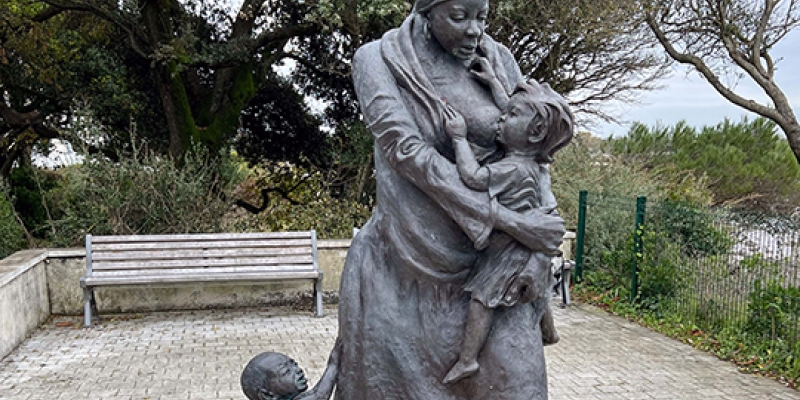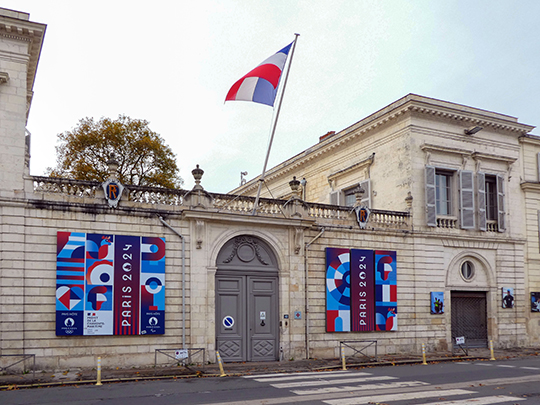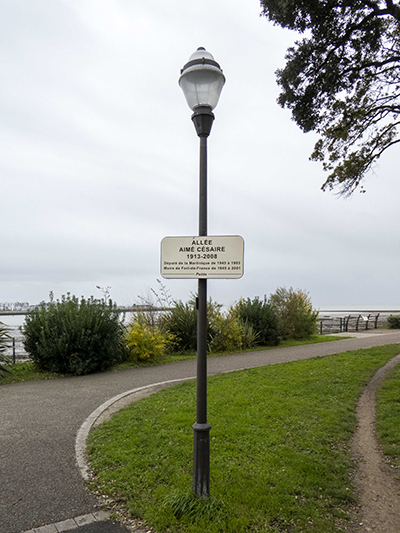
Thursday, December 5th, 2024
Our Visit to La Rochelle - Part 1
Cover Image: Clarisse, Nourrice Esclave by Woodly CAYMOTTE, dit FILIPO
© Entrée to Black Paris
When we learned that the May 10, 2024 Journée nationale de commémoration des mémoires de la traite, de l'esclavage et de leur abolition (National Day of Commemoration of the memory of the slave trade, slavery, and their abolition) would take place in La Rochelle instead of Paris, Tom and I decided to visit this port city to see for ourselves where France's first ever triangular trade voyage began.
 French government video of the May 10, 2024 ceremony
French government video of the May 10, 2024 ceremony
This year was the first in which Paris did not host the national ceremony, and we were surprised that Nantes had not been selected for this honor. Though we visited this city twelve years ago, we vividly recalled the rooms in the Museum of the History of Nantes that are devoted to the history of slavery and the slave trade, the (then new) Memorial to the Abolition of Slavery, and the illustrated panels that present this history on the route between the museum and the memorial.
As Tom researched La Rochelle to plan for our trip, we began to understand its significance with regard to slavery, the slave trade, and their abolition. After much reading and consultation with the city's visitor's bureau, we arranged for a private, guided visit of the Vielle Ville (Old Town) and the Musée du Nouveau Monde (Museum of the New World).
We also made plans to visit the Parc d'Orbigny, a 3.7 hectare (9.1 acre) stretch of greenery along the Atlantic coast that the city of La Rochelle dedicated to the memory of the slave trade and slavery on May 10, 2008.
 Commemoration Day plaque
Commemoration Day plaque
© Entrée to Black Paris
We arrived mid-afternoon on a Tuesday and spent just over two full days exploring this aspect of the city's history.
After checking into our Old Town hotel, we braved rain and strong winds to find our way to the park to see the sculpture called Clarisse, Nourrice Esclave by Woodly Caymotte, aka Filipo. At the time, we didn't know that rue Réamur, one of the streets along the route between our hotel and the park, had been home to several slave traders - including Daniel Garesché, the owner of the largest slave ship in La Rochelle.
Garesché's former abode (No. 18, rue Réamur) is now an historically classified monument.
 No 18, rue Réamur - former home of Daniel Garesché
No 18, rue Réamur - former home of Daniel Garesché
© Entrée to Black Paris

No 18, rue Réamur - historic monument marker
© Entrée to Black Paris
So is No. 40, rue Réamur, one of the addresses of the city prefecture. This building was owned by Michel Poupet, a merchant whose enslaved servant, Roc, successfully petitioned the government for his freedom in court.
 No 40, rue Réamur - former home of Michel Poupet
No 40, rue Réamur - former home of Michel Poupet
© Entrée to Black Paris
We found Clarisse as the sun was about to set. The sculpture had been unveiled by Jean-François Fountaine, Mayor of La Rochelle, during the May 10, 2024 commemorative ceremony.
 Clarisse, Nourrice Esclave in the rain
Clarisse, Nourrice Esclave in the rain
© Entrée to Black Paris
Clarisse was a woman who was purchased in Léogâne, a town in Saint-Domingue (now Haïti), and brought to La Rochelle. She was "possibly and probably" a wet nurse, whose function was to breastfeed her owner's children.
In 1793, the General Council of La Rochelle declared her "entirely free" and entitled to the same rights as other French citizens.
Because the city's wealth was largely tied to the slave trade and slavery in Saint Domingue, it is significant that the artist who created this sculpture is Haitian.
Born in 1993, Filipo hails from Port au Prince. He is classically trained and creates works that reflect Haitian history.
 Clarisse, Nourrice Esclave information plaque (detail)
Clarisse, Nourrice Esclave information plaque (detail)
© Entrée to Black Paris
By the time we found the sculpture, it was almost dark. We snapped a few pictures but resolved to return the following day after our tour of the Old Town.
Thankfully, the weather was more cooperative when we returned to the location on Wednesday. We were able to examine the sculpture closely and photograph it from many angles.
 Clarisse, Nourrice Esclave - right lateral view
Clarisse, Nourrice Esclave - right lateral view
© Entrée to Black Paris

Clarisse, Nourrice Esclave - rear
© Entrée to Black Paris

Clarisse, Nourrice Esclave - left lateral view
© Entrée to Black Paris

Clarisse, Nourrice Esclave - detail of left lateral view
© Entrée to Black Paris
 Clarisse, Nourrice Esclave - Clarisse's child
Clarisse, Nourrice Esclave - Clarisse's child
© Entrée to Black Paris
We were also able to find the signs that identify the adjacent pathway as "Allée Aimé Césaire" and honor the Martinican statesman and poet.
 Allée Aimé Césaire
Allée Aimé Césaire
© Entrée to Black Paris

Allée Aimé Césaire sign
© Entrée to Black Paris

Aimé Césaire plaque
© Entrée to Black Paris

Close up of Aimé Césaire plaque
© Entrée to Black Paris
Satisfied that one of the goals of our trip had been accomplished, we returned to our hotel.
Come back next week for Part 2 of this blog post, where I will present our guided visit of La Rochelle's Old Town.

 Our Walk: Black History in and around the Luxembourg Garden - Click here to book!
Our Walk: Black History in and around the Luxembourg Garden - Click here to book!